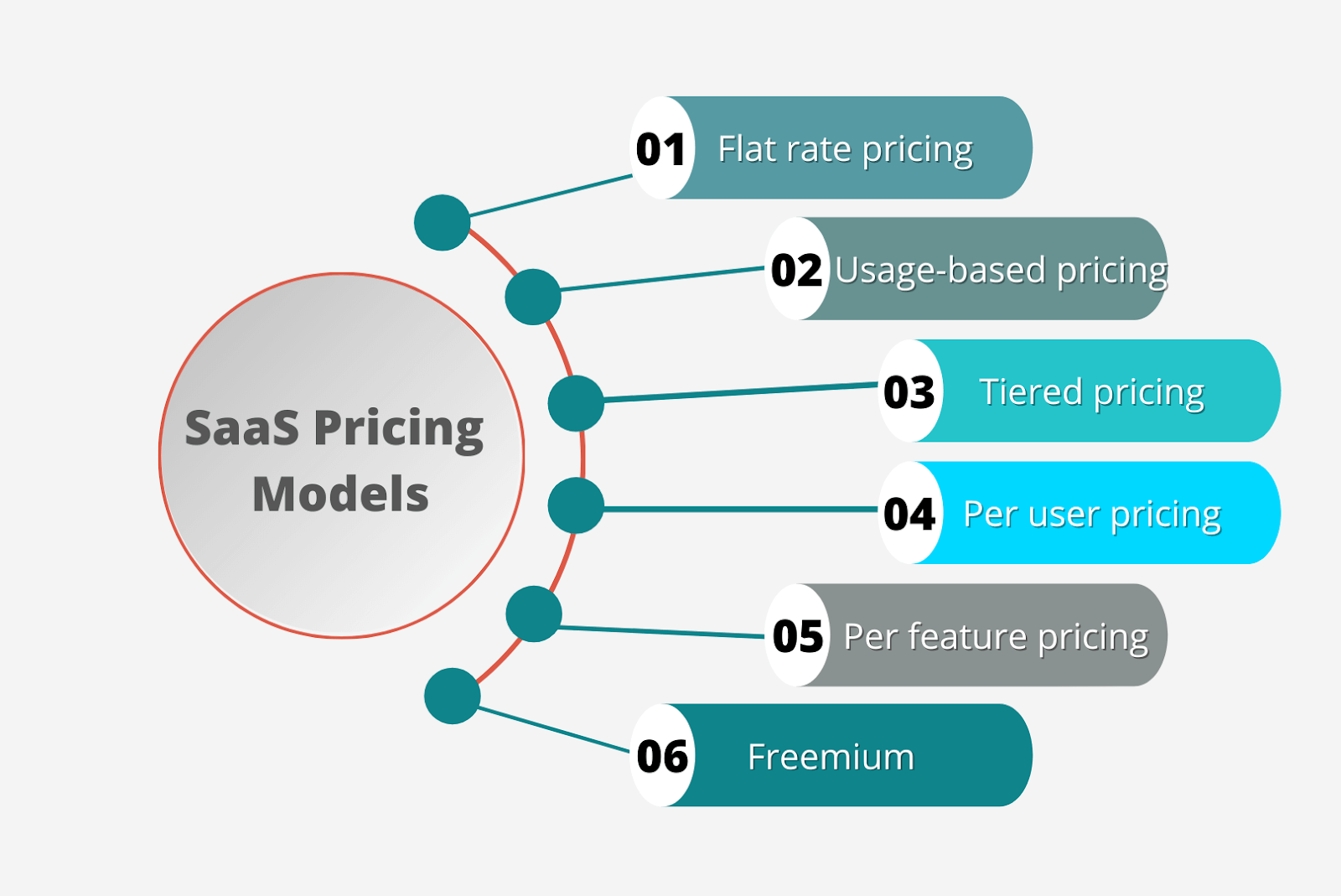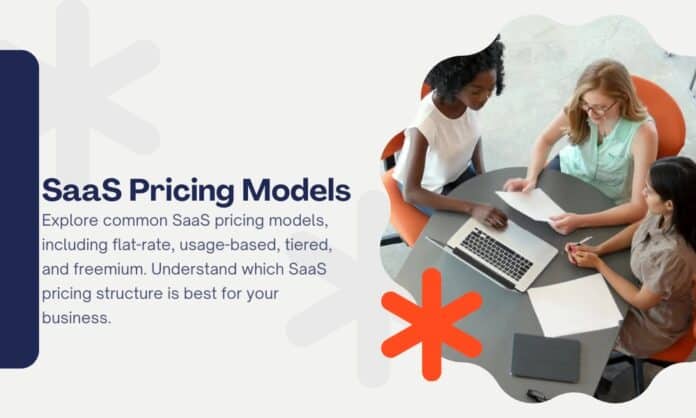The Software as a Service (SaaS) model has revolutionized the way software is delivered to businesses. By offering cloud-based solutions, SaaS companies provide flexible, scalable, and cost-effective software options. However, selecting the right SaaS pricing model is essential for sustainable growth. The pricing structure you choose will directly impact revenue, customer retention, and acquisition. In this research-driven article, we will explore the most common SaaS pricing models, examine their benefits and drawbacks, and guide you in determining the best pricing model for your business.

1. Flat-Rate Pricing Model: Simple and Predictable
1.1 What is Flat-Rate Pricing?
Flat-rate pricing is the simplest of all pricing models. It involves a single, consistent charge for access to your software.
- Single Fixed Fee: The customer pays one price, typically monthly or annually, regardless of usage.
- No Additional Charges: There are no overage costs or tiered features to complicate the pricing structure.
1.2 How Flat-Rate Pricing Benefits Businesses
- Predictable Revenue: Since customers pay a fixed amount, you can easily forecast income.
- Customer Satisfaction: Customers appreciate the transparency and simplicity of flat-rate pricing.
- Easier Marketing: The straightforward pricing model can be easier to market, especially to small businesses or startups.
1.3 Disadvantages of Flat-Rate Pricing
- Limited Scalability: As your software grows, this model may fail to capture revenue from customers using advanced features.
- Underpricing Risks: Some customers may underutilize the software while paying the same fee as others who use the full functionality.
Example: For a company like Dropbox, where users pay a fixed fee for a set amount of storage, the flat-rate pricing model works well for basic users. However, advanced users or large teams may need additional features or space, which the flat-rate model does not adequately address.
2. Usage-Based Pricing Model: Pay for What You Use
2.1 What is Usage-Based Pricing?
Usage-based pricing, also known as “pay-as-you-go,” charges customers based on the amount they use the service. This can be ideal for services with variable usage patterns.
- Per Unit Pricing: Charges are applied per transaction, data consumption, or other usage metrics.
- Scalable: Costs rise with increased usage and drop with decreased usage.
2.2 How Usage-Based Pricing Benefits Businesses
- Adaptable for Growth: Customers pay only for what they need, making the model flexible for businesses with fluctuating requirements.
- Fairer Pricing: This model ensures that customers are paying based on the value they receive.
- Encourages Usage: Customers may be incentivized to use more of the service, knowing they are only paying for what they consume.
2.3 Disadvantages of Usage-Based Pricing
- Unpredictable Revenue: Since usage varies, forecasting income can be difficult.
- Complex Billing: Tracking usage can require sophisticated systems, adding complexity and potential billing disputes.
Example: Services like AWS (Amazon Web Services) and Twilio offer pay-per-use pricing, charging based on API calls or server time. This is suitable for enterprises that require flexible and scalable cloud infrastructure.
3. Tiered Pricing Model: Tailored to Different Needs
3.1 What is Tiered Pricing?
The tiered pricing model offers multiple levels of service, each with its own set of features, providing customers with a variety of options to choose from.
- Multiple Pricing Tiers: Each tier provides additional features or resources.
- Flexibility: Businesses can appeal to a wide range of customers, from small startups to large enterprises.
3.2 How Tiered Pricing Benefits Businesses
- Attracts Different Customer Segments: Different tiers allow you to cater to a wide variety of customer types, from basic users to high-volume enterprises.
- Increases Revenue: Higher-priced tiers allow businesses to capture more revenue from customers needing advanced features.
- Encourages Upgrades: Customers can easily move to higher tiers as their needs grow.
3.3 Disadvantages of Tiered Pricing
- Customer Confusion: Without clear differentiation, customers might struggle to choose the right tier.
- Complexity: Implementing multiple pricing structures and managing customer upgrades or downgrades can become complex.
Example: HubSpot offers tiered pricing for its marketing and sales software, ranging from a free version to premium plans that offer extensive features and analytics.
4. Freemium Model: Offering Basic Access for Free
4.1 What is Freemium Pricing?
Freemium pricing offers a basic version of the product for free, with customers having the option to pay for premium features or services.
- Free Basic Version: Customers can access limited features without paying.
- Paid Upgrades: Customers can choose to upgrade to unlock advanced features.
4.2 How Freemium Pricing Benefits Businesses
- Attracts a Large Customer Base: Offering a free version makes it easier to get users on board.
- Low Barrier to Entry: Customers can try before committing to a paid plan, leading to higher conversion rates.
- Revenue Potential: Once users see the value, many may be willing to upgrade to access premium features.
4.3 Disadvantages of Freemium Pricing
- Low Conversion Rates: The free version may attract many users, but converting them to paying customers can be challenging.
- Resource-Intensive: Supporting free users can drain resources without guaranteeing revenue.
- Risk of Freebie Abuse: Some users may never convert to paying customers, affecting profitability.
Example: Spotify follows a freemium model, offering users basic music streaming for free, while encouraging paid subscriptions for an ad-free experience and premium features.
5. Per-User Pricing Model: Charging Per User
5.1 What is Per-User Pricing?
Per-user pricing charges businesses a fee based on the number of users that will access the software.
- Fixed Price Per User: Businesses pay a set price for each user accessing the service.
- Scalable for Larger Teams: The price increases as more users are added.
5.2 How Per-User Pricing Benefits Businesses
- Simplicity: It’s easy for businesses to understand and manage since the pricing is based on users.
- Predictable: Businesses can forecast costs based on the number of users they have.
- Alignment with Usage: More users typically mean more value for the company, justifying higher prices.
5.3 Disadvantages of Per-User Pricing
- Limitations for Large Teams: For organizations with hundreds or thousands of employees, per-user pricing can become cost-prohibitive.
- No Flexibility for Variable Usage: If the software’s value isn’t directly tied to the number of users, customers may feel they are overpaying.
Example: Slack uses per-user pricing, charging organizations based on the number of employees who need access to the platform.
6. Hybrid Pricing Model: Combining Features of Different Models
6.1 What is Hybrid Pricing?
The hybrid pricing model combines two or more pricing strategies to cater to different customer needs. This can include elements of tiered, usage-based, and per-user pricing models.
- Combines Features: For example, a business could offer a basic flat rate with additional charges based on usage or users.
- Customization: Provides flexibility in addressing various customer preferences.
6.2 How Hybrid Pricing Benefits Businesses
- Flexibility: This model allows businesses to create a custom pricing structure that works best for different customer segments.
- Maximizes Revenue: By mixing different models, businesses can capture more revenue across different customer groups.
- Customer Satisfaction: Customers benefit from the flexibility to choose a plan that matches their needs and budget.
6.3 Disadvantages of Hybrid Pricing
- Complex Implementation: Creating and managing hybrid pricing structures can be challenging.
- Confusing for Customers: The more complex the pricing model, the harder it may be for customers to understand and make a decision.
Example: Salesforce uses a hybrid model, combining per-user fees with tiered pricing to offer customized solutions based on customer requirements.
Conclusion
Choosing the right SaaS pricing model for your business is crucial to your growth and long-term success. Each model offers unique benefits and challenges, so it’s essential to assess your business goals, target audience, and product offerings before deciding. Whether you opt for the simplicity of flat-rate pricing, the flexibility of usage-based models, or the scalability of tiered pricing, selecting the right structure will ensure you align your pricing with customer value, enhance retention, and maximize revenue.
User Experience-Based FAQs on SaaS Pricing Models
1. How do SaaS pricing models impact user adoption and satisfaction?
SaaS pricing models significantly influence user adoption and satisfaction. Transparent and straightforward pricing, such as flat-rate or freemium models, often lead to higher user trust and initial adoption. However, if pricing structures are perceived as complex or unpredictable, such as with usage-based models that result in unexpected costs, user satisfaction may decline. It’s essential to align pricing with the value delivered to ensure a positive user experience.
2. What are the challenges users face with usage-based SaaS pricing?
Users often encounter challenges with usage-based pricing models, primarily due to the unpredictability of costs. Without clear usage forecasts, users may experience billing surprises, leading to dissatisfaction. Additionally, if usage metrics are not transparent or easily understandable, users might feel uncertain about how charges are calculated.
3. How does tiered SaaS pricing affect user experience?
Tiered pricing offers users choices that can cater to different needs and budgets. However, if the distinctions between tiers are not clearly communicated, users may feel confused about which plan best suits their requirements. Moreover, limitations in lower tiers might lead to frustration if users frequently encounter restrictions.
4. How does per-user SaaS pricing impact team collaboration?
Per-user pricing can encourage businesses to limit the number of users to control costs, potentially hindering team collaboration. When only select team members have access to the software, it can create silos and reduce overall productivity. It’s crucial for businesses to assess the value of widespread access versus the associated costs.
5. What user feedback should influence the selection of a SaaS pricing model?
User feedback on pricing should focus on clarity, perceived value, and flexibility. Understanding whether users feel they receive adequate value for the price paid can guide adjustments. Additionally, feedback on billing predictability and transparency can highlight areas needing improvement. Regularly collecting and analyzing this feedback ensures that the pricing model aligns with user expectations and enhances their experience.
6. How can SaaS providers balance profitability with user-friendly pricing?
Balancing profitability with user-friendly pricing requires a deep understanding of user needs and market dynamics. Providers should consider value-based pricing, where prices reflect the perceived value to the user. Offering flexible plans, transparent billing, and ensuring that pricing structures are easy to understand can enhance user satisfaction while maintaining profitability.
7. What role does customer support play in user experiences with SaaS pricing?
Exceptional customer support is vital in addressing user concerns related to pricing. When users have questions about charges or pricing structures, responsive and informative support can alleviate confusion and build trust. Providing clear documentation and proactive communication about pricing changes also enhances the overall user experience.
8. How do pricing models affect the perceived value of SaaS products?
Pricing models significantly influence how users perceive the value of SaaS products. For instance, a freemium model allows users to experience basic features at no cost, which can lead to a positive perception of value. However, if premium features are priced too high or not clearly differentiated, users may question their value, impacting overall satisfaction.
9. How can SaaS providers ensure transparency in their pricing structures?
Ensuring transparency involves clearly communicating pricing details, including any potential additional costs. Providers should offer straightforward comparisons between different pricing tiers and explain the value associated with each. Regularly updating users about any changes and providing accessible billing information also contribute to a transparent pricing environment.
10. What impact does pricing have on long-term user retention in SaaS?
Pricing plays a crucial role in user retention. Competitive and fair pricing that aligns with the value provided can enhance user loyalty. Conversely, unexpected price increases or perceived poor value can lead to dissatisfaction and increased churn rates. Regularly assessing pricing strategies in line with user feedback and market trends is essential for maintaining long-term retention.
Note: User experiences with SaaS pricing models can vary widely based on individual needs and expectations. It’s advisable to consult multiple sources and consider your specific context when evaluating pricing strategies.
Check out: Web Plus SaaS Business Model Explained!

